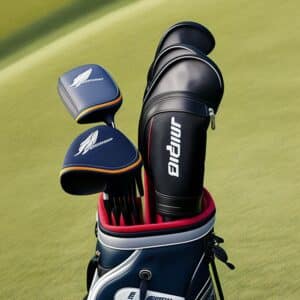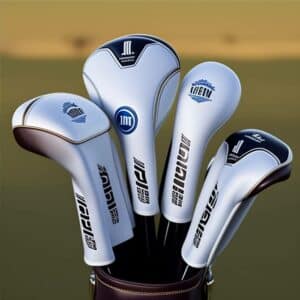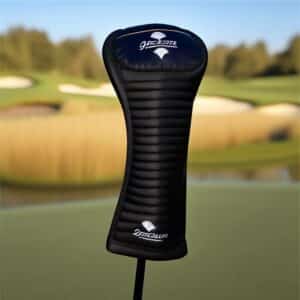Last Updated on June 8, 2023
Golfing is an activity that requires a great deal of skill and finesse. Head covers are essential for protecting golf clubs from dirt, dust and other environmental hazards. In order to ensure the best experience on the links, having high-quality head covers is paramount. This article will provide you with step-by-step instructions on how to make golf head covers. The process entails selecting appropriate materials, designing the right shape and size, as well as adding any desired embellishments. By following these steps, you should have no difficulty in creating your own custom golf head covers.
Additionally, this article will explore some of the benefits associated with making your own head covers rather than purchasing them ready-made. Handmade items can be tailored to fit perfectly while also offering a personal touch which adds character to each set of clubs. Furthermore, by taking control over every aspect of production, individuals can avoid paying high prices for store-bought head covers without compromising on quality or style.
Finally, you will be equipped with all the information they need to create sturdy yet stylish bespoke golf club protectors for yourself or others. With detailed guidance provided throughout this article, it is hoped that everyone’s craftsmanship skills will reach new heights and elevate their game accordingly!
Types of Materials Used to Make Golf Head Covers

Golf head covers are designed to protect golf clubs from dust and moisture. They come in a variety of materials, ranging from wool and leather to synthetic fabrics. Each material has its own benefits and drawbacks depending on the user’s needs.
The most commonly used type of fabric for making golf head covers is wool or felt. Wool is lightweight yet durable, making it ideal for protecting wooden club heads during storage or travel. It also helps keep clubs dry by wicking away excess moisture that can cause rusting or corrosion over time. However, this material may be prone to fading if exposed to direct sunlight for prolonged periods of time.
Leather is another popular option when selecting a material for golf head coverings due to its durability and natural water resistance qualities. Leather provides an extra layer of protection while still remaining breathable enough to prevent overheating caused by trapped air inside the bag. Though more expensive than other types of golf head material, leather offers superior long-term protection against dents, scratches and wear-and-tear damage caused by frequent use or poor maintenance habits. Ultimately, choosing the right head cover fabric depends on personal preferences as well as cost-effectiveness for the intended purpose.
Tools and Supplies Needed
In order to make golf head covers, certain tools and supplies are needed. A sewing machine is highly recommended due to the extra strength it provides when stitching the fabric together. Golf needles, which typically have a larger eye than regular needles, should also be used as they can easily stitch through multiple layers of material in one go. Sewing thread must match the colour of the fabric so that no contrast appears on the finished product; likewise, fabric scissors will ensure that pieces are cut accurately and with precision. All necessary materials should be gathered before beginning construction of the golf head cover for ease in completing it successfully. Lastly, iron may be required for pressing seams flat prior to joining them together.
Selecting the Right Fabric Pattern

When selecting the right fabric pattern for a golf head cover, it is important to consider the design of the product. Golf fabrics come in many different colours and patterns, ranging from solid colours to intricate designs. It is important to choose a pattern that complements the overall design while still standing out on its own.
The size and shape of the head cover should also be taken into consideration when choosing a fabric pattern. Smaller prints are ideal for smaller-sized covers, whereas larger bold prints work better for larger ones. The type of material used also needs to be considered since some materials may shrink or fade over time due to exposure to sunlight or water. Careful attention needs to be paid not only to colour but also to texture when selecting the correct fabric pattern for a golf head cover. By carefully considering these factors beforehand, one can ensure that they select an appropriate pattern which will complement their desired design perfectly.
Sewing Techniques
Sewing techniques are essential for creating golf head covers. The first step is to gather the necessary sewing supplies, such as fabric and thread, a pair of scissors, pins, needles, and a tape measure or ruler. It may also be useful to have an iron on hand for pressing seams and wrinkles in the material.
- Measure the volume of fabric needed with a measuring tape or ruler.
- Cut two identical pieces from the chosen fabric using sharp scissors.
- Sew together both parts by making small stitches along the edge of each piece; use strong thread that matches the colour of your fabric.
- Create loops at either end so that they can be easily secured onto golf clubs; add extra padding if desired before stitching them into place.
The next step is to finish up any details that make your golf head cover unique and attractive – this could include adding decorative touches like buttons or ribbons to give it more character and personality! With these steps completed, you will have created a durable and stylish golf head cover that will keep your clubs safe during playtime or transport.
Cutting the Pieces for the Head Cover
Cutting the fabric for a golf head cover is an important step in creating it. To start, select a pattern that best suits the desired design and then gather all necessary materials such as scissors, pins, thread, needle and fabric. Cut two pieces of the main fabric that are slightly larger than the paper pattern to allow room for seams and hems. Ensure that both pieces have their edges facing outwards before pinning them together at specified points on the sewing pattern. Next, cut one piece each from the interfacing material and lining fabric; these should be smaller than the main fabric by about 1/4 inch (0.6 cm). Now place interfacing over the wrong side of one piece of main fabric with both fabrics being placed right sides together and then pin all around; repeat this process with the second set of fabrics except leave 2-3 inches (5-7 cm) open along one edge for turning out later.
Assembling the Pieces
Once the pieces of fabric needed to make a golf head cover have been acquired, assembling them into a finished product requires several steps. Sewing techniques will be necessary in order to join the various fabric components together. Careful stitching should be done along all edges and seams before attaching any additional embellishments, such as monograms or rhinestones. All trimmings and decorations must also be securely attached with stitches that are strong enough to withstand wear and tear over extended periods of time. After completing these tasks, the newly created golf head cover can then be tested for durability by gently tugging on all areas where sewing was used. If no problems arise from this final test, the project is ready for use or display.
Testing the Fit of the Head Cover

Once the head cover is complete, testing its fit to the golf club is essential. To do this, place the headcover over a golf club and ensure that it fits snugly without being too tight or loose. If there are any gaps between the fabric and the clubhead, add more stuffing until it fits tightly. It should also be easy to remove when needed. Additionally, check that all parts of the design remain in place while the headcover is on; if some pieces have loosened during the construction process, stitch them back into position carefully. Furthermore, make sure that any tassels or cords drape smoothly around the edges of the headcover so they don’t become tangled upon removal. All these elements together will guarantee a secure and properly fitting head cover for your golf clubs. After examining each aspect mentioned above, you can feel confident that you’ve created an effective golf club head cover.
Finishing Touches
Once the basic construction of the golf head cover is complete, one can add a variety of finishing touches to personalise and customise it. Embroidery designs are popular for creating logos or patterns on the fabric. This can be done with a machine or by hand. Decorative stitching such as buttonhole stitch, running stitch or blanket stitch may also be used to create interesting details like borders around the edges or holes to thread ribbons through. Decorative buttons can also be added if desired; these could be covered in matching fabric, contrasting ribbons or even sparkly sequins. Finally, adding embellishments such as beads, feathers, and tassels will give the finished product an extra luxurious feel.
Frequently Asked Questions
What Is the Best Type of Material for Golf Head Covers?
The best type of material for golf head covers will depend on several factors such as budget, personal preference, climate conditions and amount of use. Leather provides superior water resistance but requires more frequent cleaning than other materials. Synthetic fabric can withstand extreme temperatures without fading or cracking while being lightweight and breathable. Neoprene offers excellent shock absorption qualities, making it ideal for protecting delicate club heads from accidental bumps or drops.
When considering what the best type of material for golf head covers is, some points to consider are:
- Flexibility – Choose a material that allows you to easily slide the cover over the clubhead without snagging or tearing
- Durability – Ensure that the material can handle regular use and resists dirt build-up
- Comfort – Look for materials that provide comfort during both warm and cold weather play
- Water Resistance – Find out how well each material will stand up against moisture and sweat
- Aesthetics – Consider both colour options and texture designs when selecting a style of cover
No matter which type of material you choose, all should provide adequate levels of protection against scratches, dust build-up or even dings caused by impact with another object during transport. It’s important to weigh up all available options carefully before settling on one particular type so that your investment in golf head covers lasts long into the future.
How Do I Know If the Fabric Pattern I Choose Is Right for Golf Head Covers?
The best way to identify what kind of fabric and pattern works well for making golf head covers is by researching different types of material available on the market today. Additionally, research can help determine whether or not particular designs or textures suit the desired outcome. For example, some fabrics may provide more cushioning protection, while others may add an aesthetic appeal to the finished product. Moreover, observing patterns featured in existing commercial products can give insight into which styles work best for creating a functional and attractive head cover design.
Conclusion
When selecting fabric for making a golf head cover, it is important to choose a strong material that will provide adequate protection while allowing the clubhead to breathe. The chosen pattern should also be aesthetically pleasing so as to appeal to the golfer’s individual style.
The right tools are necessary when making a golf head cover; such items include scissors, needles or a sewing machine, thread and measuring tape. Sewing skills must also be employed in order to ensure proper fitment of the head cover onto the club. There may be certain methods specific to creating golf head covers which require further research by the maker prior to beginning their project.
Ultimately, taking into account all aspects of making a golf head cover is paramount for the successful completion of this task. Selecting an appropriate type of fabric with sufficient strength will ensure the durability and longevity of the end product. Additionally, utilising correct equipment and following specialised instructions can lead to quality results when crafting these protective pieces for golf clubs.



